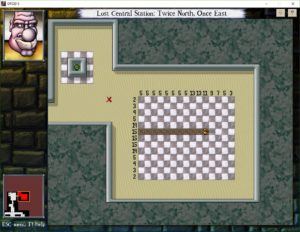The Second Sky: Railroading
One of the big surprises in The Second Sky is that the Empire has an underground rail system. It was built mainly to facilitate the collection of surface-dwellers, but Beethro can ride it. He doesn’t even have to trick anyone or sneak on board or anything like that. Because he still holds the position of First Slayer from back in The City Beneath, the Empire’s resources are at his disposal, to some extent, when they aren’t trying to kill him. Once again, it must be remembered that the Empire has no coherent system of policy, and Beethro can easily be considered an enemy of the state one moment and a VIP the next.
After a certain point in the story, after helping Tendry get into some trouble, Beethro flees the Patronage’s robots —
There are robots in this game. I haven’t mentioned them before, but I’ve been seeing a lot of them lately. The game calls them “constructs”, to fit them a little better into the basically-still-a-fantasy-despite-all-the-sci-fi-stuff setting, but they’re clearly robots. They’re a little like smarter versions of golems, in that they leave a pile of debris when killed, but with one major difference: until you clear the room, robot debris comes back to life every 30 turns. They remind me of the trolls in Nethack in that regard, and, like Nethack trolls, one way to keep them from reviving is to push them into a body of water with a pushing weapon. Another is to push them onto tiles infested with oremites, which they otherwise avoid. That’s a good example of how the game creates new exploitable complexity through special cases in combinations of elements, something that also reminds me of Nethack. There’s so much of this going on in the game that I don’t have time to describe it all in the kind of detail I gave to the earlier episodes.
Beethro flees the Patronage’s robots by getting on a train without an intended destination, just “Get me out of here”. He winds up at a forgotten station, which becomes a hub for side-quests. Once you have access to that, you can go anywhere in the world — okay, I talked about a world map before, but it turned out to be divided into sections, with only one section available at a time, and that limitation is gone. (Except that it won’t take me to the distant past, which is a bit of a shame, because I still have at least one unsolved puzzle back there. But we have the Restore menu for that.) In fact, the sections I passed through before seem to have sprouted some new levels, where I can go to solve bonus puzzles for collectibles, which are tracked at a special room in the train station.  One of these collectibles: RCS tokens. I had found one of these earlier, before I had its context. “RCS” is the name of the train system, and what the tokens do is give you access to rooms containing nonogram puzzles laid out on the floor. Solve these, and your reward is more bonus levels.
One of these collectibles: RCS tokens. I had found one of these earlier, before I had its context. “RCS” is the name of the train system, and what the tokens do is give you access to rooms containing nonogram puzzles laid out on the floor. Solve these, and your reward is more bonus levels.
I commented before about how each title in the DROD series does more with the bonus content than the last, and I was wondering how The Second Sky would manage to one-up Gunthro and the Epic Blunder, with its trail of clues leading to an entire extra level. It turns out that something like half the content of the game is extra levels this time.
The thing I really like about this is that it gives the game a sense of breadth. We’re not in a linear sequence of levels any more. We’re out exploring, pursuing whatever challenges we come across. It’s a design pattern I associate with JRPGs — most of the Final Fantasy games start off linear, but then you gain access to an airship and you’re suddenly free. I find it significant that the opening up of the DROD world is also accomplished by obtaining a vehicle, albeit one more suited to the largely subterranean setting.
 Comments(0)
Comments(0)